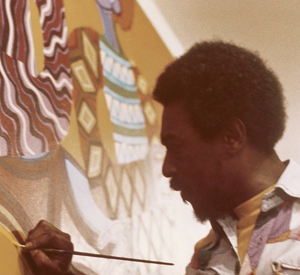Charles Searles facts for kids
Quick facts for kids
Charles Searles
|
|
|---|---|

Searles painting a mural c. 1975
|
|
| Born |
Charles Robert Searles
July 11, 1937 Philadelphia, Pennsylvania, United States
|
| Died | November 27, 2004 (aged 67) New York
|
| Known for | painting, sculpture |
|
Notable work
|
"Filas for Sale"; "Celebration" |
Charles Robert Searles (born July 11, 1937 – died November 27, 2004) was an amazing African American artist. He was born in Philadelphia and studied art at the Pennsylvania Academy of the Fine Arts. Charles Searles created art from the 1960s until he passed away in 2004.
Contents
Charles Searles: Art and Travel
Charles Searles earned special scholarships that let him travel. In 1972, he visited countries like Nigeria, Ghana, and Morocco. These trips really inspired him!
When he returned, he made a series of artworks called Nigerian Impressions. One famous painting from 1972 was Filas for Sale. It showed bright masks and cool patterns.
Searles got his first big art job in 1974. He was asked to paint a huge mural in Philadelphia. This mural was for the William H. Green Federal Building. A study for this mural, called Celebration, is now owned by the Smithsonian American Art Museum. It shows masked dancers and colorful figures.
Music was a big inspiration for Charles Searles. In 1975, he created his Dancers series. These artworks really showed how he could capture movement in his paintings. You can see his piece Dance of the Twin Souls at the Pennsylvania Academy of Fine Arts Museum.
He lived in Philadelphia until 1978. Then, he moved to New York City. In the 1980s, he started making very large sculptures. Some of these were Warrior (1987) and Freedom's Gate (2000). These sculptures were super tall, about 8 to 10 feet high!
Charles Searles passed away in 2004. His art was also part of a special exhibition in 2015. It was called We Speak: Black Artists in Philadelphia, 1920s-1970s. This show was held at the Woodmere Art Museum.
Amazing Art Shows
Charles Searles's art has been shown in many cool exhibitions. These shows helped people see his unique style and powerful creations.
New Black Artists
Charles Searles was part of an exhibition called "New Black Artists." This show was at the Brooklyn Museum in 1969. It featured 49 artworks by 12 different artists. After Brooklyn, the exhibit moved to Columbia University.
Universal Reflections of Color and Rhythm
After Searles passed away, his art was shown in a special exhibition. This show was at Winston-Salem State University's Diggs Gallery in 2009. It displayed over 60 of his paintings, sculptures, and drawings. These were artworks he made later in his life.
Charles Searles: The Mask of Abstraction
La Salle University had a big exhibition of Searles's work in 2013. It was at the La Salle University Art Museum. This show featured 52 artworks from different times in his life. It included his early drawings, sculptures, and later abstract paintings.
Charles Searles: In Motion
Also in 2013, The Tyler School of Art at Temple University displayed 17 of Searles's large paintings and sculptures. This exhibition was very special. Students even performed dances and created art inspired by Searles's work!
Expanding the Legacy: New Collections on African American Art
Some of Charles Searles's personal papers and drawings were shown in an exhibit. This was at the Lawrence A. Fleischmann Gallery in Washington D.C. from 2016 to 2017. The exhibition showed how artists explored their cultural identity and important events through their writing and art.

